An Introduction to Game Theory in Poker
One of the first lessons most people learn about poker is regarding pot odds.
For instance, when facing a half pot river bet, you must decide if your hand will beat your opponents more than 25% of the time to profitably call. Since your opponent bet half the pot, you are getting 3:1 on your money, so if you are at least 25% to win then you should call, otherwise fold. Early poker theorists also looked at this situation from the bettor’s side: when betting half the pot on the river with a bluff, a player only needs his opponent to fold 1/3 of the time to show a profit.
But both of these considerations only make up a small piece of the puzzle. Let’s take it one step further: since the person facing the bet knows that his opponent needs him to fold only 1/3 of the time to show a profit, he must call at least 2/3 of the time to prevent his opponent from showing an immediate profit with his bluffs. Taking it further, knowing his opponent will call at least 2/3 of the time, the bettor will make sure to not bluff too frequently to avoid losing money to an opponent taking an unexploitable approach to the game. This cycle continues, creating a Nash Equilibrium solution that refines the betsize and ranges of each player given what they reached the river with. The discovery of these last steps and their implications signified the takeover of a game theoretic approach to poker that is used by top professionals today.
An important thing to note about this approach is that it doesn’t take into account player tendencies at all. It’s only concern is finding a way to play a range of hands unexploitably, meaning it does not try to make as much money as possible with a tailor made strategy for each opponent, it just tries to create a strategy that is unbeatable. Unbeatable and maximally exploitive are two very different things.
Let’s look at a few poker situations using a game theoretic approach, not only to help you cement your understanding of game theory in poker, but so you can look at situations you may have faced in the past from a different angle.
Preflop
You raise second to act in a 6 handed cash game with AsQs to 3bb and get 3bet to 10.5bb by the button. You are both 100bb deep, should you reraise, call, or fold?
The traditional approach to poker would take into account what your opponent’s range is and how AsQs is doing against that range to figure out if a call is profitable or not. It could look something like this:
My opponent is very tight, so I expect him to 3bet AA KK QQ JJ AK for value and almost never bluff. Against this range, my hand is about 32.06% to win at showdown.
I am getting 15:7.5 or exactly 2:1 odds so I need to be 1/3 to win to call, but since I am less than that I will fold.
A game theory approach is very different. Remember, we don’t care about our opponent’s strategy, only our own.
First we need to consider our opening range in this spot. My personal opening range second to act in a 6 handed game is this:
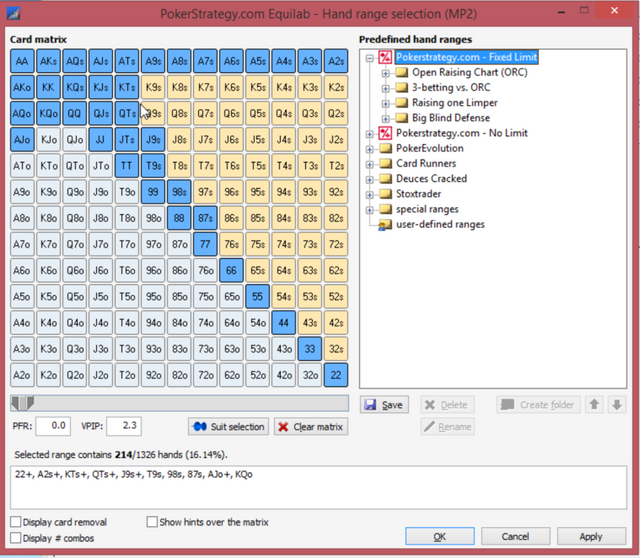
Now we consider our opponent’s bet. He is risking 10.5bb to win 4.5bb, so if we were to only reraise or fold he would need us to fold 70% of the time or more to win money. However, when we call he can still win the pot: not only does he have position and is representing a very strong hand, but even his bluffs have equity against our calling range— sometimes they flop strong hands.
So since we are calling more than we are reraising, we have to continue with far more than 30% of our hands to prevent our opponent from profiting immediately. Coming up with the exact number requires rigorous work, but assuming it is around 50% means we need to continue with over 8% of hands (remember we opened just over 16% of hands). AQs is easily a top 5% hand, so we absolutely want to continue with this hand and will continue with many worse hands too.
We probably want to 4bet AA, KK, and AKs because they are still ahead of our opponent’s 3betting range, and we want to call with our middle pairs, big suited cards, and AKo/AQo, and then we can 4bet bluff a few hands that are slightly too weak to call like ATs and AJo. So our overall continuing range will at the tightest look like this:
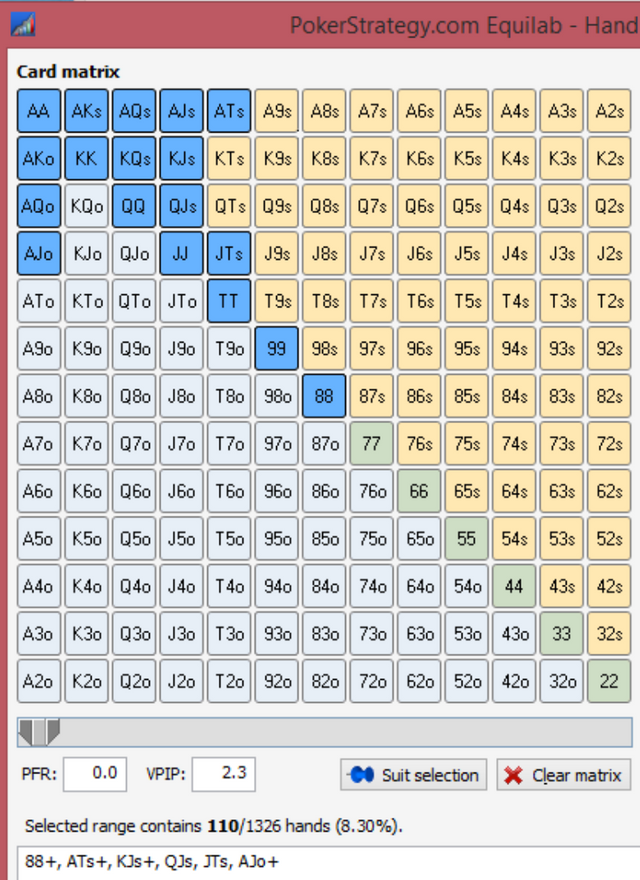
If more hands are profitable to continue against a 3bet then we can call those. But the key point is that we cannot continue with a smaller range of hands than this given our opening range. If you open wider (which may be profitable as is noted in the comment section below), then you have to defend even more hands (which also may be profitable to do). These postflop calculations are very difficult to make and a lot of it is either guesswork or empirical based after extremely large samples of hands, but the underlying theory is based on defending a minimum amount of hands to prevent opponent freerolling with bluffs.
We can similarly use game theory on our opponent’s side to figure out how often he should be 3bet bluffing versus 3betting with strong value hands, and then we can work out 4bet and 5bet ranges too. As said above, when these ranges are played with and improved they approach Nash Equilibrium solutions, but the beginning of that process started with game theory.
Facing a Continuation Bet
Your opponent raises preflop to 3bb on the button and you call in the big blind with 7s6s. The flop comes Kc 8s 4h. You check and your opponent bets 2/3 pot. Do you raise, call, or fold?
A traditional approach to poker may fold: you only have 4 outs to make a straight and are getting only 2.5:1 to call. But a game theory approach paints a different picture.
Suppose you reraise 10% of hands for value and call preflop with this range:
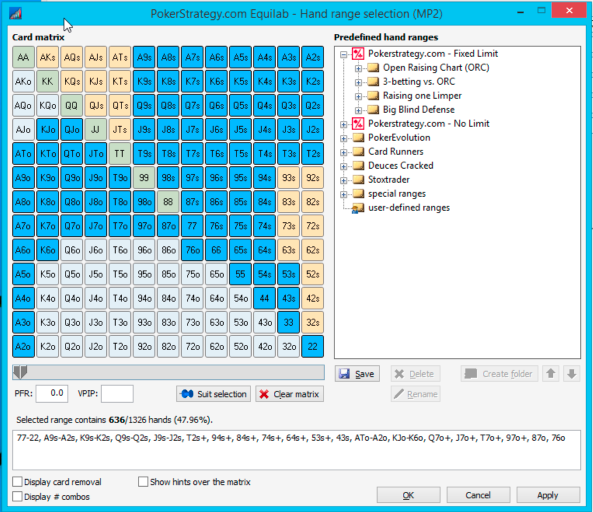
Since our opponent is risking 2/3 to win 1, he needs us to fold over (2/3)/(5/3) = 40% to profit immediately with his bluffs. Thus we must continue with 60% of our hands to prevent it and have an unbeatable strategy. If we only continued with pairs then we continue on the flop with 18.96% of hands:
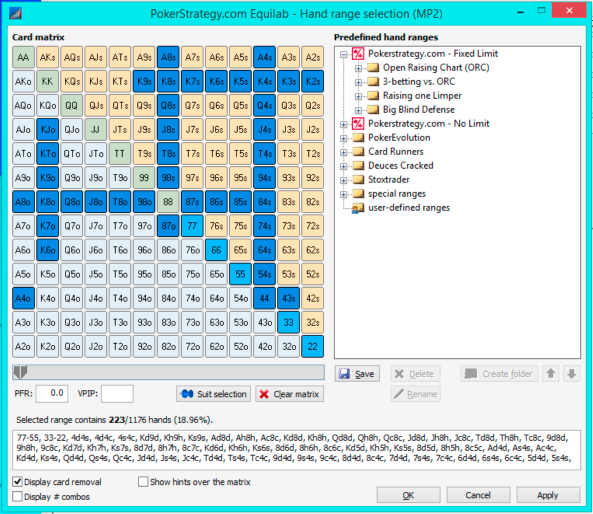
This is not nearly enough, 60% of 48% is 28.8%. We need over another 10% of hands to prevent our opponent from freerolling with his bluffs! And it needs to be even higher than 60%, because some of his bluffs may turn a pair or a flush draw after we call and be able to continue and win the hand, thus we may want to continue against his bet around 70% of the time or 33.6% of hands.
Let’s add in ace high (likely doing ok against his wide cbetting range), all gutshots (we can bluff these on the turn or river if we miss), and a few other hands like T9s, 97s, 96s etc which have 3 to a straight flush:
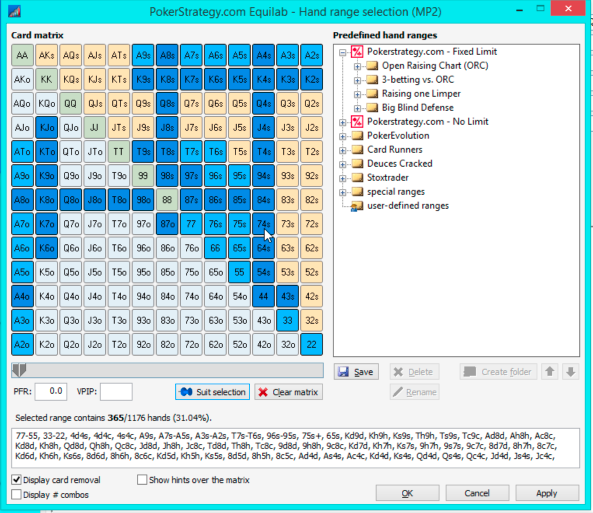
Not quite 33.6% but pretty damn close. We won't be able to defend enough on every flop, sometimes a flop just hits a game theory optimal opening range harder than it hits a game theory optimal defending range from the big blind, while other flops we will be able to defend more than is necessary. But in general, we should aim to reduce the number of immediate profit situations our opponents have (with their bluffs) in every situation on every street, which helps create an unbeatable strategy.
So of this range, roughly 60% of it has at least a pair and the other 40% of it has some type of equity in the way of gutshots, ace high, or backdoor draws that can turn outs. Our range will be strong enough on the turn so that our opponent cannot mindlessly bet all of his hands there to make us fold.
One thing to note is that we aren’t check raising anything on the flop, even our hands like 44, K8, and K4 which are 2 pair or 3 of a kind. This is because for one, we need more strong hands on the turn to protect us from pressure and two, we probably win more money by calling with these hands and giving some of our opponents bluffs a chance to improve and put more money in later.
This same process can be done on the bettor's side to see which hands the preflop raiser should cbet, what he should do if someone does check raise, what he should check back, and what he should do on different turns.
Given how many completely different situations there are in poker, it is impossible to plan ahead for all of them.
Different stacksizes, raise sizes, people opening from different positions facing different actions and entirely different board runouts. It is impossible for humans and even computers right now to enumerate all of them. However, having a knowledge of game theory allows you to utilize it in every scenario to help create as close to unexploitable strategies as humans are capable of in the moment.
This material was necessary for future poker blogs I write, and I will use this game theory approach to craft what I believe are strong strategies.
My name is Ryan Daut and I'd love to have you as a follower. Click here to go to my page, then click  in the upper right corner if you would like to see my blogs and articles regularly.
in the upper right corner if you would like to see my blogs and articles regularly.

I am a professional gambler, and my interests include poker, fantasy sports, football, basketball, MMA, health and fitness, rock climbing, mathematics, astrophysics, cryptocurrency, and computer gaming.

Is this theoretical or do you really not have cr range on the k84 board? I generally like to cr my gutshots there and some hands like 9Ts with 2 overs to 2nd + backdoors, which I balance by also raising k4 and 44. This does leave my cc range a little weaker than yours, but I think we can easily get away without being 100% balanced against all but the most observant opponents who we play very regularly.
I also open slightly wider utg1 adding ATo KJo Q9s, T8s, 97s, 86s and 76s, but i do remove 22/33.
Do you consider any of those leaks?
Thanks again for sharing, always enjoy seeing the small differences and intricacies in people's play.
I don't think you should c/r the K84 board in this spot. Your range is a little weaker than the button's (since you 3bet big pairs and broadway linear range) and your turn range ends up too weak. It's also much harder to balance having two ranges. of course there can be exploitable adjustments to make, but I think the GTO approach is no c/r range here.
utg1 I think ATo is a fold, KJo is close, Q9s/T8s/97s/76s could definitely be raises. 33/22 could be folds. The key point is that I think 3x raising >20% here is a leak (really think >18% is a strategic leak too, but I guess people can make 20% work?). I could see ways to add 1-4% though (maybe call 3bets slightly wider with hands like T9s/77) and vary the actual hands you have, but I felt raising around 16% seemed like the best strategic approach. What is your continuing range (4b/call ranges) vs button 3bets?
Ya makes sense about the cr.
And I think 20% HJ (we're still talking 6max right?)is definitely no problem, even a few higher should be ok at most tables at the low-midstakes (no idea about the limits you play at but most of the cg streamers that are good seem to be opening anywhere from 20-25%.
hj v btn i 4b something like JJ-AA, AK+ A2-A5s 76s and might extend to a few more scs or suited aces depending on the table, calling most of the rest and folding out the weakest couple %.
I was wondering about calling 3bet range too. I prefer calling JJ/QQ over 4betting because the calling ranges get pretty iffy when you exclude those hands, and if you fold too much then you're just overfolding. And it's not like they print money vs a JJ+ AK 5b range
Sorry i have calling range in there I just didnt word it well. And ya I think that makes a lot of sense for your limits but at the lower stakes ($50-$200nl) (or even higher on places like bovada I've heard) there's enough spew that you can def fistpump gii QQ, with JJ being much closer (and probably bad at a lot of tables).
Did a bit more work, I like this range:
(17.65%) 44+, A2s+, K9s+, Q9s+, J9s+, T8s+, 97s+, 87s, 76s, AJo, KJo
Can still continue with the 8.3% range I posted earlier. Maybe add in 77/T9s to continue with a 50% range again, but I suppose having some cold 4bets from the blinds helps a little.
ya that looks pretty spot on for my taste. if you look at guys like doug though im pretty sure he's opening like K6s+, J8s+ some lower scs, and all the weak offsuit broadways (plus 22-33 i think).
That seems insane, that's like a 27% range? Button/cutoff can each 3b 12-13% linear and punish it so badly.
I'm sure he plays it up for stream tho, who knows what actual ranges are and obv varies depending on the lineup.
I'd rather throw in the A2s-A5s than the ATs or AJo.
But that's really just nitpicking. Great post over all! This is what modern poker strat looks like.
Yup I agree. Whatever the strongest hands with blocking capability that we are folding should be 4bet. AJo and ATs are a call in this situation vs most buttons, so we can go ahead and 4bet the A2s-A5s like you suggested. I originally wrote the post dealing with UTG vs button and decided to change it to hijack due to buttons possibly wanting to flat hands as strong as QQ vs UTG opens and mentally didn't adjust the 3bet calling range to wide enough.
Cool man! I havn't read it but thanks for this! Upvoted
Stoked to read this tonight! Thanks for posting!